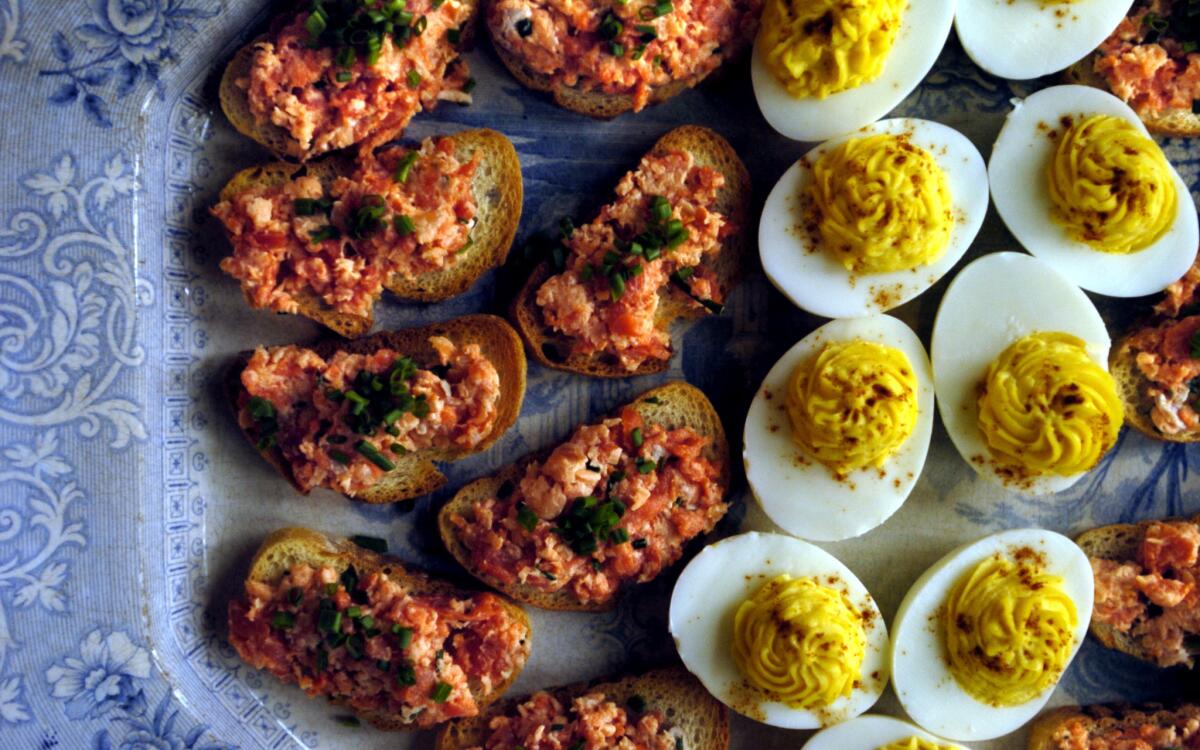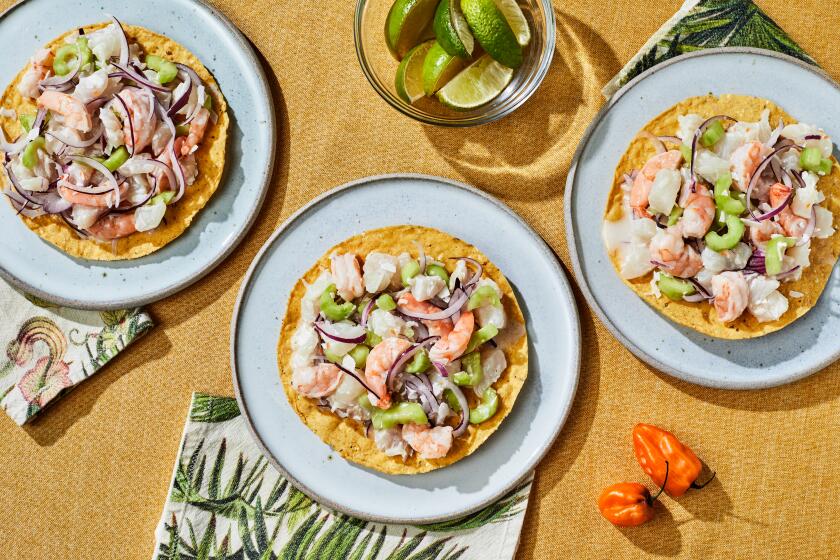Salmon rillettes

Self-control is never one of my strong suits, but I can resist out-of-season food as easily as a teetotaler tunes out Robert Parker. There are a dozen reasons why, but the most basic is simply the pleasure principle. Abstinence does make the heart grow fonder.
Like anyone, I can get worked up about the first corn in summer and squash in fall after a year’s wait, but it’s spring fruits and vegetables that have a power all out of proportion to their short season. Nothing else imparts that feeling of renewal, of new beginnings. I make a ritual of steaming my first bunch of asparagus and sauteing my first fresh morels and braising my first fava beans. An artichoke is something to sit down and contemplate leaf by leaf on first meeting after a year apart; rhubarb almost looks good enough to eat raw after a long winter’s exile with pears and apples.
But after enough one-on-one encounters, I’m ready to put all of those edible harbingers together in one meal to prove spring has really arrived. And it feels so celebratory that it has to be shared. You can do it with a sit-down dinner or as a buffet, but either way, accentuating the season is a spirit-lifting theme for feeding friends or family. An open house on Easter would be a good excuse to bring on all of spring in one spread.
The best part of planning the menu is that the main course is almost preordained. This time of year, either lamb or ham seems to be the natural choice for the protein at the center of the table, and I’m not going to argue with centuries of tradition. But there’s a bonus: The same accompaniments can work with either meat. What complements the dark intensity of the lamb is just as harmonious with the sweet fattiness of the cured pork when you’re playing off the seasonal palette.
As a starter, the simplest idea is radishes, one of the more easily overlooked symbols of spring. They’re at their best now; all you have to do is wash, trim and serve them the way more and more restaurants do lately: with nothing more than sweet butter and sea salt.
Salmon is another emblem of the season that could be served very simply -- just smoked slices on warm toasts with a little lemon. But you can also turn it into rillettes, which are easily made and taste very light despite their richness. These days I buy only wild salmon, which is cleaner and has better flavor with less fattiness than the scary, flabby farmed kind. For the rillettes I use both fresh and smoked salmon, knocking off an idea from the fish temple Le Bernardin in New York. The fresh salmon is barely cooked so that you can easily mash it into the minced smoked fish. You get a more intense flavor and just the right texture. A little creme fraiche makes the mix spreadable, a little lemon makes it livelier and a lot of chives give it the essential element of spring.
As the first side dish, you have to have potatoes to take advantage of the perfectly tiny ones popping up in farmers markets everywhere. They have a taste like no others, along with an almost buttery texture and skins so thin you don’t want to peel them and lose that extra layer of flavor. You could get away with simply roasting them, but because they cook so quickly when they’re so small, you can turn them into a tian, the Provencal cousin of a gratin.
I slice them thin and layer them with three other elements of spring: fresh artichoke hearts, fresh morels and the green garlic that is light-years away from the aggressive mature kind. This dish needs no cream for richness or flavor as wintertime potatoes do. You can use just olive oil and a little chicken stock to moisten them, then cook them sealed in foil until they turn completely tender. A dusting of bread crumbs and grated cheese baked on top will give textural contrast.
The real thing
A big platter of cold asparagus, with or without a sesame-soy mayonnaise for dipping, would be a perfectly acceptable finishing touch. But if you combine asparagus with all the other just-picked spring vegetables -- fava beans, baby carrots, tiny leeks and especially those sweet fresh peas that will turn woody in just a couple of weeks -- you can quintuple the seasonal sensation.
I use only the perfect tips of the asparagus -- big bunches are so cheap and good right now that you can almost be wasteful with them (or you can use the stalks in another dish, such as soup or a frittata). The baby carrots need to be blanched, but otherwise the dish is as simple as a stir-fry: All the vegetables cook so evenly they can just be braised in butter and a little vegetable demi-glace, which has a profound flavor that picks up all the high notes without overwhelming them the way cream would. A bunch of chervil, the forgotten vibrant spring herb, brings all the parts into harmony.
For dessert, this is the time of year when you could get out a bowlful of berries and some mascarpone and call it a night. But rhubarb is too good not to make something of it. I turn it into a classic crisp, with pecans for extra crunch in the topping, and then gild it with strawberry ice cream. The sharp combination of flavors, so much more common in pie, tastes like the season without the cliche.
Combine the vermouth, bay leaf, sea salt and peppercorns in a nonreactive saucepan and bring to a simmer. Add the salmon cubes and cook 15 seconds exactly. Remove with a slotted spoon and drain well, then place in a mixing bowl.
Mash the salmon cubes with a wooden spoon until chunky-smooth. Add the smoked salmon, creme fraiche, 2 tablespoons chives and the lemon juice and mix well. Taste and add the hot sauce, salt and pepper. Add more lemon juice and/or creme fraiche if you like. Chill 1 hour to meld flavors. Makes about 3 cups.
Return to room temperature before serving. To serve, spread on ficelle slices and sprinkle with the remaining chives.
Get our Cooking newsletter.
Your roundup of inspiring recipes and kitchen tricks.
You may occasionally receive promotional content from the Los Angeles Times.















